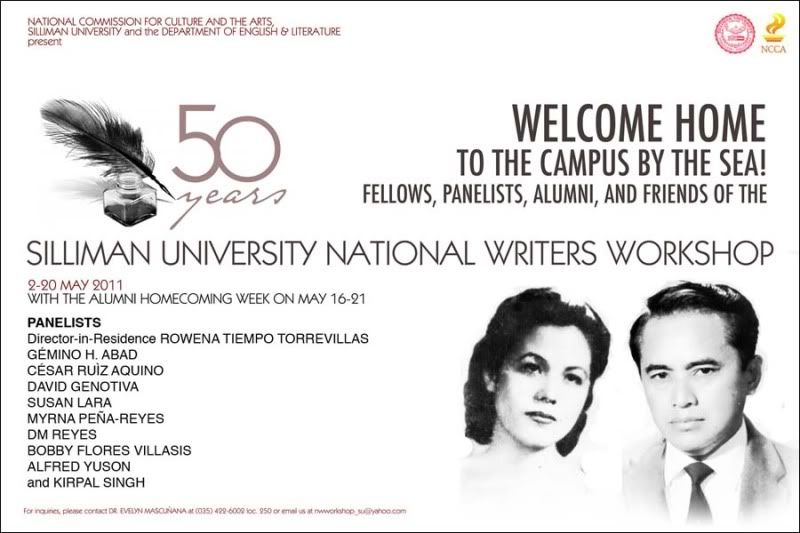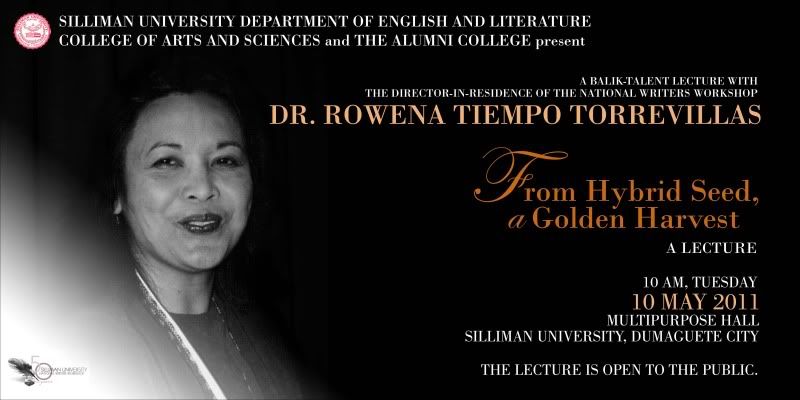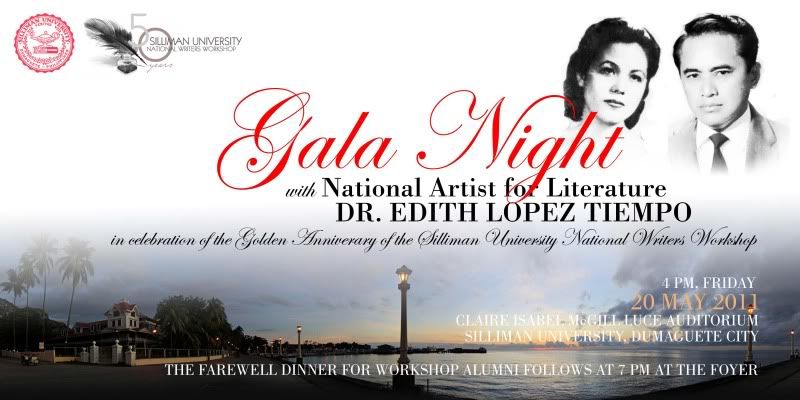Sunday, May 08, 2011
 9:51 PM |
Some Stories From Fifty Years of Writing
9:51 PM |
Some Stories From Fifty Years of Writing

We begin with stories of how things began.
My own love affair with the Silliman University National Writers Workshop in Dumaguete began eleven years ago, when I was one of nine young writers granted a three-week fellowship to a summer of writing and book talk.
It led me to a discovery—in a very big way—to the treasures of Philippine literature. But before that summer, like many other people of that certain age (I was just graduated from college), I knew nothing. Perhaps a tiny bit of Nick Joaquin, maybe a little Kerima Polotan. I remember reading the entirety of Edilberto Tiempo’s
A Stream at Dalton Pass and Other Stories when I was 10, because there was a copy of the book in my house, for some reason—and when I was very young, I devoured all books and magazines I could find.
But I knew I liked writing. Some other people discovered that for me. My teachers in West City Elementary School’s SPED Program for Fast Learners were suitably impressed, I guess, by the compositions I churned out for our theme assignments—you know the sort, “How I Spent My Summer Vacation,” “My Best Friend,” “My Most Cherished Memory”—that they made me editor-in-chief for the school organ
The Western Star, a mimeographed loose-leaf effort that had an indelible impression on me. I am now extremely sorry that cannot remember the name of the paper adviser, but she taught in the regular sections, and she was a kind woman who told me I could write. I didn’t know what she meant by that.
Later on, spurred by the very thorough language lessons of Ms. Bennie Vic Concepcion in grade school and the gentle goading of Prof. Gina Fontejon and Prof. Alejandra Bañas in Silliman High School, I was possessed with the idea that writing was my vocation. After a not-so-delightful detour through the wrong course, I ended up in a discipline that was all about practical writing and modern communications. Somewhere along the way, my college composition teacher, a fictionist by the name of Timothy Montes, one day wrote in the margins of my BC 12 essay: “You must apply to
The Weekly Sillimanian.” And so I did.
Tim writes about this time in his introduction to my forthcoming short story collection
Beautiful Accidents (published by the University of the Philippines Press): “In the early ‘90s when I started teaching in Silliman, when I myself was always lassoed by the label ‘a promising young writer,’ I came across an essay in my freshman English class that made me think of my own promise. For here, indeed, was someone who wrote better than I did when I was his age. When I asked the student who wrote the essay to stay after class, I was later confronted by a self-conscious impish smile that tried to hide a nerdiness, and a something-else that only teenagers are capable of exuding: a secret hunger that can only be projected onto the night.
“He was, he said, a Mass Com major, and I thought that unless he was going to have the gumption of a maximalist writer like Tom Wolfe, he was not fit to parse out his sentences for the press. For his kind of writing was more literary than journalistic, and he simply could not hide his style. I exempted him from my cut-and-dried lectures and assigned him books to read instead. In return, he submitted the obligatory expository essays even as I encouraged him to do whatever he wanted as he jazzed around in his reading and writing.
“And just as I predicted, complaints from his readers in the student paper where he wrote a column started coming in. They could not understand him; he was verbose; he was obfuscating. And as consolation, I told him he was writing from a Faulknerian tradition, and it was no use cramping his own style in the ideal of Hemingway. At that time I was reading Nabokov and thought style was all.
“I think he actually sought me out in all his English and literature classes for he was there semester after semester, feeding my teacherly ego in return for a confirmation of talent that was not not mine to bestow. I just knew he had the talent to become a writer; the rest was life and hard work. The way he used language as a supple medium made him one of those writers capable of expressing varied experiences that he would face. He was a film buff and organized the cineaste club in the university, and sometime in his junior year he went to Japan as an exchange student. All these qualities and experiences would seep into his writing…”
By the time I graduated from college, it was again Tim who gently took me aside, and said, “You must apply for a slot in the National Writers Workshop.”
I remember asking him, “Why?” when in fact the question that was in my head was “What is that?” I’ve heard only a little of the workshop when I was in college—but my world was small then, and I really knew nothing, even if, as all young people are wont to think, I thought I knew everything.
Tim told me to prepare three stories. Perhaps those stories I’ve already written for his undergraduate Creative Writing class. There was a deadline. There was the wait. Several days later, I got a letter from Dr. Edith Tiempo. It was graceful in its congratulations, and it gave me the details of the fellowship, and told me to make an appearance on the Monday of the first full week of May of 2000, at nine o’clock sharp, at the Dragon Room of the CAP Building along the Boulevard.
That Monday, at the appointed time, I showed up with Jean Claire Dy, a co-fellow from Silliman. I would soon meet the other writing fellows, of various preoccupations, from all over the Philippines and the world (one was from Hawaii, and one was studying to become a priest)— Vincenz Serrano, Isolde Amante, Alex de los Santos, Elmer Pizo, Gerald Feljandro Ramos, Noel Villaflor, Roberto Salva, Francis Ted Limpoco, Ulysses Navarro, and Wayne Mark Lopez. I would soon notice the “Mount Olympus” in the room—the head table where the writing luminaries were. They were to be our panel of writer-critics, a tableau of faces that changed from week to week.
The faces on that first day were all unfamiliar to me, but Claire seemed to know more. “That’s Ophelia Dimalanta,” she pointed out to one writer at the panelists’ table. “That’s Jimmy Abad, I love him. That’s Krip Yuson. That’s Cesar Ruiz Aquino. And that, my dear, is Mom Edith. Edith Tiempo.”
I kept nodding and nodding, filing away the names to memory.
There would be more names in the coming years—because, after that summer of 2000, I too would return to the workshop, first as an auditor wanting to reconnect with a cherished memory, then later as the unofficial
yaya of several batches of fellows, and finally as a member of the organizing team at the Dumaguete Literary Arts group, and later Silliman University, that would help put out the annual editions of this longest-running creative writing workshop in Asia.
I had no idea it was going to be the summer my life changed forever.

The story of the Silliman University National Writers Workshop in Dumaguete—which celebrates its fiftieth year this May—officially begins in 1962. That was the year it was founded by the late Dr. Edilberto K. Tiempo and his wife, the National Artist for Literature Edith L. Tiempo. They became simply Doc Ed and Mom Edith to several generations of Filipino writers, a sort of familiarity that says a lot about the kind of workshop Dumaguete promised.
Its influence is now legendary. The poet Cirilo Bautista once said, “The amount of learning these writers got from this workshop is incalculable, and is measurable only in the way they have contributed to the qualitative and quantitative growth of our literature. Being a pioneer, [it] occupies a premier position in the history of creative writing in the Philippines.”
The Tiempos, together with its first panelists, the National Artists Francisco Arcellana and Nick Joaquin, ushered in a golden age of writing, and Dumaguete in Negros Oriental has somehow become the heart of the country’s literature—everyone’s literary hometown.
But perhaps its true genesis goes even farther back, to the end of World War II.
“In 1946,” Rowena Tiempo-Torrevillas once wrote, “my father was offered a scholarship by the Presbyterian Board of Missions, enabling him to do graduate work in the United States, at Stanford. He was readying himself for the scholarly regimen of the classics, and doing a refresher course in Latin, among his preparations, when my father was asked what area he wanted to specialize in at Stanford. ‘Creative writing,’ he said. ‘There are a number of novels I am going to write, and I need to know if I’m writing them effectively and well.’
“’Oh,’ the Presbyterian Board officer told him, ‘then there’s only one place for you to go. Iowa.’ Dad had to look up Iowa in the encyclopedia, and he was a bit puzzled at what he read. ‘Isn’t that where…they grow corn?’”
Iowa, right smack in the cornfields and silos of the American Midwest, indeed grew corn. But Doc Ed was soon to learn there was a man there, a poet named Paul Engle, and that he ran what was and still is considered the best creative writing workshop in the world: the Iowa Writers’ Workshop at the University of Iowa. “And that is how my Dad,” Rowena Torrevillas continued, “took a freighter across the Pacific, then a train halfway across the continent from San Francisco to Iowa City. And one morning, carrying his belongings in an Army-issue duffel bag, he crossed the Pentacrest on the campus to find the postwar temporary quarters in the Nissen huts, the quonset building where Paul Engle was holding the Writers’ Workshop.”
By 1947, his wife Edith joined her husband to also take part in the program. When they returned to the Philippines in 1951, Silliman was already abuzz with creative writing. The campus was sprouting literary enthusiasts, among them Aida Rivera-Ford, Rodrigo and Dolores Feria, and Ricaredo Demetillo. The Tiempos made creative writing an area of concentration for English majors in the English Department—and soon that paved the way to preparations in 1961 to hold a workshop similar to the one they attended in Iowa. The following year, it became fully operational.
The years to come would bring future luminaries often at the very beginning of their writing careers, people such as Gregorio Brillantes, Rogelio Sicat, Ninotchka Rosca, Elsie Martinez Cosculluela, Federico Licsi Espino, Salvador Bernal, Rene Estella Amper, Virgilio Almario, Ricky Lee, Conrado de Quiros, Leoncio Deriada, Estrella Alfon, Eric Gamalinda, Marjorie Evasco, Danton Remoto, Vicente Groyon III, Ruel S. De Vera, Miguel Syjuco, Lourd Ernest de Veyra, Lakambini Sitoy, Sarge Lacuesta, Dean Alfar, Naya Valdellon, Angelo Suarez, Adam David, among many others...
Today, the workshop’s alumni number above six hundred. Their memories of three weeks in during a Dumaguete summer remain indelible. Timothy Montes writes: “It was a common story we told: meeting Doc Ed was a turning point in life. I remember him, the first time I joined the workshop, taking me aside and saying, ‘You can write.’ And I began to write seriously.”
The poet Cesar Ruiz Aquino tells the story of being the first workshopper: “We were a very young college boy when we came to Dumaguete for the first time in the summer of 1962... It was a letter from a man named Dr. Edilberto Tiempo that brought it about. The letter was an invitation to join the 1962 Workshop in April… We accepted, of course, full of madness and innocence... [He] met us at the wharf, aboard a
tartanilla… It was just after dawn. We can’t recall certain details. For instance, we can’t recall how we knew it was him or how he knew it was us. We rode the tartanilla to town, to the English Department at Hibbard, to the Alumni Hall where the workshoppers would be housed, then to the Cafeteria for breakfast.
“How quiet the town was, how still. Even then it felt like memory. Time, a full, primeval river, moved in eddies... It was the morning of creation and the dawn seemed to cling to everything. In the evening, across from our window, played Vic Damone on the jukebox singing, incredibly, ‘Tender is the Night.’ And in the morning of the next day we met the next to come, Willy Sanchez who looked at us with contempt until, in no time, we began tramping through the campus, Katzenjammered the olds, crossed the hooligans, wrote lines under a cypress tree, befriended inanimate objects. Willy performed, we watched. Nick Joaquin exclaimed at the caf: ‘Franz, I think they’re writers!’”

This year, we add 15 more writers to the august list of fellows: Charmaine Carreon, Evangeline Gubat, Jeffrey Javier, Allen Samsuya, Alyza Taguilaso, Glenn Diaz, Christine Lao, Emmanuel Lava, Andrea Macalino, Marius Monsanto, Philline Donggay, Rogelio Garcia Jr., Miguel Sulangi, Elaine Tobias, and Maria Villaruel.
This year’s panel of critics is composed of Director-in-Residence Rowena Tiempo-Torrevillas and Dumaguete-based writers Myrna Peña Reyes, Bobby Villasis and Cesar Ruiz Aquino, as well as guest panelists Susan Lara, DM Reyes, Dave Genotiva, Ricky de Ungria, Gemino Abad, and Alfred Yuson. For this summer, internationally-acclaimed Singaporean writer Kirpal Singh will also be sitting in with the panel.
The 50th Silliman University National Writers Workshop, scheduled on May 2-20, is sponsored by the National Commission for Culture and the Arts and Silliman University, coordinated by its Department of English and Literature.Labels: dumaguete, dumaguete writers workshop, negros, philippine literature, silliman, writers, writing
[0] This is Where You Bite the Sandwich
GO TO OLDER POSTS
GO TO NEWER POSTS

















 9:51 PM |
Some Stories From Fifty Years of Writing
9:51 PM |
Some Stories From Fifty Years of Writing


